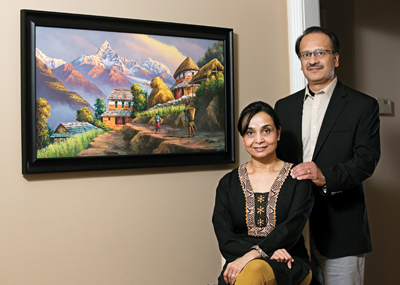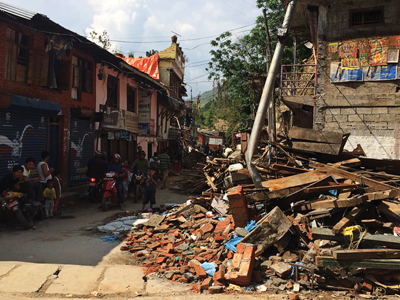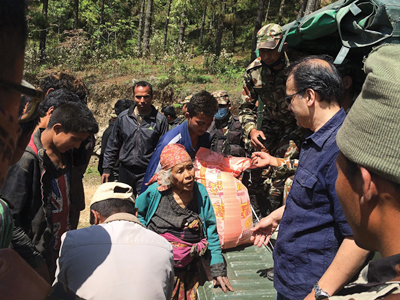Community Pillars
SIU physicians lead efforts with American Nepal Medical Foundation to help earthquake victims
Written by Rebecca Budde • Photography by Jason Johnson and Janak Koirala
"When there’s an earthquake, health care is what people need," says Janak Koirala, MD, MPH, professor and chair of the division of infectious disease who saw first-hand the devastating effects that the April 25 earthquake had on the people of Nepal. Though thousands of  miles apart, Dr. Koirala and his wife, Sangita Basnet, MD, were two leaders in the efforts to help the people of Nepal through the American Nepal Medical Foundation (ANMF). Dr. Basnet is an associate professor of pediatrics and chief of the Division of Pediatric Critical Care and medical director of the Pediatric Intensive Care Unit at St. John’s Children’s Hospital.
miles apart, Dr. Koirala and his wife, Sangita Basnet, MD, were two leaders in the efforts to help the people of Nepal through the American Nepal Medical Foundation (ANMF). Dr. Basnet is an associate professor of pediatrics and chief of the Division of Pediatric Critical Care and medical director of the Pediatric Intensive Care Unit at St. John’s Children’s Hospital.
"Dr. Basnet woke in her Springfield bedroom around one o’clock in the morning on April 25 to her phone ringing. On the other end of the line was her younger brother who lives in California calling to tell her of the devastating earthquake that had hit their native country of Nepal where some family members and friends still live. And Dr. Basnet also had someone else on her mind: two days prior, her husband, Dr. Koirala, had left for Nepal to speak at a conference for the Society of Internal Medicine of Nepal.
Everything was chaotic after that call," Dr. Basnet recollects. It was a long three-hour wait before she heard news. "I sent text after text, ‘Are you OK? Please text me!’ and finally, Janak texted back." Shortly after hearing of Dr. Koirala’s safety, Dr. Basnet’s sister-in-law called to let her know that Dr. Basnet’s 88-year-old father and other family members were safe; fortunately, her mother was visiting her brother in the United States. "As soon as she said that they were safe, the connection was lost."
“We can’t save the world ... but if we can get things started, we can serve as a model for others.” - Dr. Koirala & Dr. Basnet
It was just minutes before noon in Nepal. Dr. Koirala and more than 100 attendees were listening to a panel of speakers when "it felt like I was in a ship that hit a big wave," he said. Small quakes are the norm in the area, but this was very different. The lights went out, and the room’s large, heavy doors flew open. He caught them before they injured anyone. It lasted less than a minute, but Dr. Koirala says that the scene was chaotic, people falling as they tried to run out of the building. "It felt like the ground was going up, and I was running uphill."
Though he eventually made a connection with his wife back home via cell phone, Dr. Koirala couldn’t get through to his parents on the local phone lines. Many homes in Nepal are old and were likely to collapse in an earthquake of this magnitude. The roads were broken and blocked by fallen debris, making travel to his parents’ home challenging. He and a friend found a cab driver who took them about two-thirds of the way into the city, and then they walked. Dr. Koirala’s parents, who live in a newer home that was built to be earthquake proof, found his parents safe.
In the United States, a sleepless Dr. Basnet and other members of the ANMF took charge to raise funds for relief efforts. "Facebook came alive," Dr. Basnet says. "The news started coming: the historical sites were demolished, all the deaths. I’ve never felt this way before, and I never thought I’d feel this way – the intense heartbreak." Within half an hour, the foundation began fundraising. "We were all texting from different corners of the United States. People just started giving, and within the first hour, the amount skyrocketed past $20,000. I think that all the Nepalis people living here and local people too, felt like I did: helpless." In the first few days, their efforts raised more than $100,000 to provide food and medical supplies through the ANMF. People are still donating; the total exceeded $800,000 as of early June.
The ANMF was established in 1997. The non-profit organization works to support the Nepali people’s efforts to improve their health status through medical care, medical education and medical research in order to create a self-sustaining heath care infrastructure – a mission much like SIU School of Medicine’s. Most ANMF members are originally from Nepal but currently live in the United States. Many, like Drs. Koirala and Basnet, attended medical school and worked in the medical field in Nepal and are familiar with the needs and problems of the local population.
It’s obvious that the like-minded physicians who met during medical school days in Nepal are proud of their native country as they use their expertise to further the mission of ANMF. Dr. Koirala helped to establish an infectious dise ase fellowship in Kathmandu through the Tribhuvan University, Institute of Medicine. He is a founding member of ANMF and has served as president, secretary and board member. Dr. Basnet, who currently serves on the board, partnered with a hospital in Kathmandu to build a neonatal center and pediatric intensive care unit. However, this time the funds raised for ANMF were needed for more urgent health care needs.
ase fellowship in Kathmandu through the Tribhuvan University, Institute of Medicine. He is a founding member of ANMF and has served as president, secretary and board member. Dr. Basnet, who currently serves on the board, partnered with a hospital in Kathmandu to build a neonatal center and pediatric intensive care unit. However, this time the funds raised for ANMF were needed for more urgent health care needs.
Dr. Koirala extended his stay in Nepal for an additional 10 days. He relied on his medical expertise and local connections to use the money that was being raised back home for the ANMF to help the people of Nepal. He says the first few days were disorderly within all organizations; members of the ANMF began a needs assessment. "The government was paralyzed: their buildings were cracked and they couldn’t go inside," Dr. Koirala says. Aid organizations and volunteers coming into the country had little initial direction.
ANMF stepped in. A collaboration was formed with the government, Nepal Army, the health ministry, the hospitals and various aid organizations. He found out that the nurses and physicians were barely keeping up and hadn’t left the hospital in three days.Above Image Caption: Destruction of the earthquake in Nepal in the town of Chisapani, Nuwakot.
"I went to the hospital and told them that we could buy the supplies through the money raised by ANMF, but at first they weren’t sure what they needed or what to expect." The volunteers purchased $30,000 worth of vaccines, orthopaedic materials, surgical supplies and other hospital supplies in the first week; by the month’s end, supplies distributed totaled more than $150,000 raised by ANMF.
"Once we knew the hospitals had what they needed, we went to the mountains because we heard that whole towns were turned to rubble, completely collapsed." Landslides and cracked roads made travel into the villages difficult. The military provided transportation and protection to the team of doctors traveling to the mountains of Nepal to bring medical care and more than $20,000 worth of medical supplies, food, blankets, chlorine tablets and more than 1,000 much needed tents in those first weeks.
"For a few days after the earthquake, no one slept inside. Many lost homes and others were too scared to go in if they had a home left," Dr. Koirala says. "They were in desperate need of tents. In some areas not a single house was standing. All you could see was tents and rubble." In one area that Dr. Koirala visited, more than 50 patients needed and were given direct clinical care. The supplies for the hospitals and villages were purchased through personal connections and on good faith until the ANMF’s funds could be transferred into the country.
"Every day Janak and the other ANMF workers sent updates from Nepal, so we posted them to Facebook and Twitter," Dr. Basnet says. "The ground team worked so hard; the acute need for relief is a little bit less. We were lucky that Janak was there; I’m not sure how effective it would’ve been if someone from here with authority in the ANMF hadn’t been there to take charge."
But the physicians emphasize that the efforts are a partnership. "ANMF won’t do anything unless Nepal tells us to. We are sitting outside and realize that. We have to listen to what they need; we are also foreigners," Dr. Basnet says.
While in Nepal, Dr. Koirala was able to help leaders plan for possible long-term issues and discussed prevention of outbreaks of infections. "When we went to the villages, we saw more fly population from people being outside, lack of bathrooms, dead livestock," he says. The longer the conditions stay like this, the more likely that the water supply will become contaminated. In addition, the monsoon season is imminent, and people continue to sleep outdoors during the cool evenings, making them more susceptible to illness. "We saw that in Haiti – cholera outbreaks and other catastrophic conditions." Aid workers will need to focus on vaccines for infections such as hepatitis A and typhoid fever along with carcass removal and temporary sanitation systems, according to Dr. Koirala.
The ANMF and Nepal government have identified three areas needing the most help: public health, mental health and infrastructure. "The hospitals are still working outside in tents and health posts (clinics) are down, so that means unhygienic conditions," Dr. Basnet says. "And the people are totally terrorized."
Dr. Basnet tears up, "The stories are amazing. It’s so heartbreaking; you see the worst scenario – nothing to wear, homes destro yed – but they’re still smiling. They offer others food. The Nepali people inherently are very, very kind, very peaceful."
yed – but they’re still smiling. They offer others food. The Nepali people inherently are very, very kind, very peaceful."
"We are overwhelmed by the support shown by friends and colleagues at the School of Medicine and in Springfield," Dr. Koirala says. "We want to thank everyone for their support on behalf of Nepal’s earthquake victims."
The ANMF set up a schedule of volunteers so that someone familiar with the status of the work will always be in Nepal. Dr. Basnet left for Nepal on May 27 tor a three-week rotation to help the efforts. On her second day in Nepal, her team drove five hours to a remote village and saw more than 200 patients, including 60 children. Dr. Basnet was the only pediatrician on the team. She plans to start a pilot public health and outbreak prevention project at a village before she heads back to the US.
"We can’t save the world," Dr. Basnet says looking at her husband who finishes her thought, "but if we can get things started, we can serve as a model for others."
Right Image Caption: Dr. Koirala (on right in blue) works with the ANMF and Nepal military to take supplies, food and shelter to the people of Nepal.